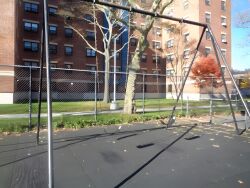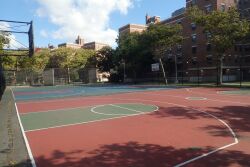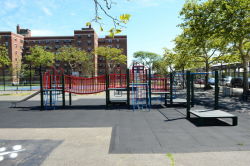Arverne Playground
Arverne Playground
Sometimes names can form a chain, linking people and places in unusual ways. Remington Vernam (1842-1907) was born in McConnville, New York, and moved to New York City with his family in 1854. He attended public school and went on to law school. He first came to Far Rockaway as a retreat from the stress of his work as a lawyer, but soon saw an opportunity to develop the area.
Together with Edgemere, the Arverne neighborhood was the last part of the peninsula to be developed. The area was plagued by confusion of land titles, and people who bought property sometimes found that the person who had taken their money had built a home and lived on the land but did not hold the title. More often there were legal disputes over the boundaries of the properties. As Vernam was a lawyer, he was able to both earn money by resolving the contested titles of other area property owners and skillfully acquire property for himself. After consolidating a considerable amount of land, he replaced the dunes with paved streets, sewers, and sidewalks. He built a large hotel as the centerpiece of his new upscale resort community. His wife Florence, noticing that he signed his checks "R. Vernam," decided to name the hotel and surrounding community as a variation, "Arverne," which she thought had a nice French sound. Vernam opened the hotel on Independence Day in 1888, and sold 17 homes during the following year. Despite the success of the community, Vernam's good fortunes lasted less than a decade. By 1896 he was bogged down in lawsuits over the ownership of some of his properties, which finally pushed him to bankruptcy in 1898. He finally retired and moved to Oakland, New Jersey.
The community he founded was incorporated as Arverne-by-the-Sea in 1895 and then became part of Greater New York in 1898 as part of the consolidation of the cities and towns in the five boroughs. The town's character changed once rail service in the early 1900s made it more accessible to Manhattan, removing the qualities of a distant resort. The addition of Cross Bay Boulevard in 1925 also reduced its exclusive remoteness. Initially it changed into a middle class commuter suburb, but then had economic trouble during the 1950s, and in 1964, was finally designated an urban renewal area. The city cleared thousands of homes in Arverne and neighboring Edgemere, planning to replace them with new housing. The new housing never materialized, however, and large areas have remained vacant, waiting to be redeveloped.
The property for this park was bought by the city on November 4, 1948, in conjunction with the Arverne Houses, an early public housing project that was realized before the neighborhood was cleared. The layout of the park was submitted exactly one year later, but the Board of Estimate did not approve it until 1951. The Arverne Houses opened in 1951, and in 1952, official ownership of the playground was transferred from the New York City Housing Authority to Parks. In 1994, the playground was completely reconstructed with $294,000 provided by Mayor Giuliani. Arverne Playground now offers excellent play equipment, benches, and basketball and handball courts.
Check out your park's Vital Signs
Clean & Safe
Green & Resilient
Empowered & Engaged Users
Share your feedback or learn more about how this park is part of a
Vital Park System










